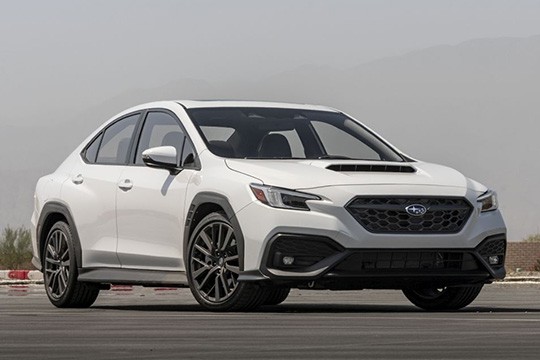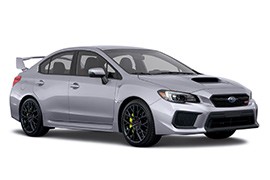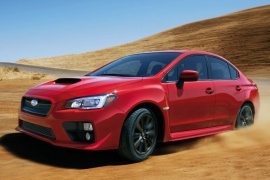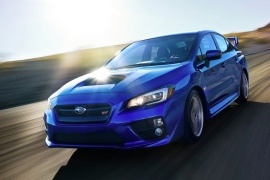SUBARU WRX Models/Series Timeline, Specifications & Photos
First production year: 2014
Engines: Gasoline
Subaru introduced the second generation of the WRX in 2021 for the 2022 model year, and the automaker managed to keep the car close to the hearts of rally enthusiasts, despite ditching the Impreza nameplate from it.
In the past, the WRX was the punchier version of the Impreza lineup, being overtaken just by the hard-core Impreza WRX STI. With those versions, Subaru claimed 122 podiums out of 193 rally starts. That was an impressive record, and so were the six world titles in the drivers or the manufacturer's standings. On the streets, fans all over the world bought the WRX as the legit successor of the Impreza. It impressed them thanks to its snappy acceleration times and excellent handling thanks to its unique symmetrical all-wheel-drive system. Furthermore, it was quicker than many other more expensive sports cars. Last but not least, it was a four-door sedan that could easily do the job as a family vehicle. Subaru kept the same recipe; it just improved. For the 2022 model year, the WRX returned to satisfy its customers with an even better vehicle in terms of driving experience and modern features that matched the competition.
The redesigned front fascia featured a pair of angry-looking headlights flanked by the C-shaped LED daytime running lights. Between them, there was a hexagonal-shaped grille where the Subaru badge took center stage. On the lower side of the bumper, Subaru added a black, unpainted section that included an additional air intake flanked by oversized scoops, which housed the fog lamps.
From its profile, the car boasted an unusual, for a regular sedan, body kit consisting of plastic moldings around the angular-shaped wheel arches and the side sills. The automaker knew that the WRX was an excellent vehicle to be thrashed around on gravel roads, so it protected the bodywork with these. The greenhouse sported slim A-pillars, and a curved roof line sloped down towards the rear deck by the C-pillars and the rear window. Finally, out back, the WRX featured corner-mounted taillights with horizontal V-shaped LED lamps, while below, under the bumper, a large diffuser flanked by four exhausts completed the image of this sports sedan.
Subaru offered the WRX in a few trim levels, and only the top version, named the GT, sported Recaro sports seats. The rest of the range was sold with high-bolstered seats covered with a mix of fabric and leather. Fronting the driver was a mixed instrument panel that housed large dials of the speedometer and the rev counter, flanking a TFT display showing data from the car's onboard computer. The automaker installed an 11.6-inch multimedia screen on the center stack. Between the front occupants, the WRX featured a center console that housed the gear stick and the manual handbrake. The 60/40 split-folding bench seat in the back could accommodate up to three passengers.
Under the hood, there was only one engine option: a 2.4-liter turbocharged flat-four, which produced 271 PS (267 hp) and was sent to all corners via a six-speed manual. Depending on the grade and market, a CVT with fixed gear ratios was also available.
Subaru introduced a 209-unit limited edition of the WRX STI at the 2019 North American International Auto Show, unveiling the full potential of an already respected four-door sports car.
Subaru Tecnica International was founded in 1988 to create and develop race cars for Subaru. The STI wizards' vehicles won six world rally championships. Perhaps more importantly, the podium presence rate was high: out of 193 race starts in official STI cars, 122 finished in the top three places. But fast forward three decades, and in 2018, the Japanese brand decided to go all-in and create a unique vehicle for the American market, and that was the Subaru WRX STI S209. While it shared many parts with its regular sibling, the car was at a much higher level. It was the most powerful, best-handling STI road car ever created. What started as a project ended up as a huge success. Moreover, all 209 units vanished quickly.
Someone didn't have to be a keen Subaru fan to notice that there was something different about the S209 compared to the regular WRX STI. Sure, none of them looked like grocery-getters. They both looked mean. But the S209 had something unique. Its front bumper featured a broad lower air intake flanked by huge side scoops, which sported three horizontal slats to increase downforce to the front axle. Furthermore, a set of winglets were found on each side of the lower bumper. From its profile, the enlarged wheel arches looked similar to those from the WRX STI, but they sported the STI S209 unique badges on their rear area.
Thanks to the 4.9-inch (12.5 cm) ground clearance, the car's profile boasted a racing appearance. Its 19-inch BBS light alloy wheels were available in yellow, similar to those installed on the rally car. STI wrapped them in 265/35R Dunlop tires for increased performance. Despite the car's steep price, the automaker offered it in just two colors: white or blue. Out back, on the deck, the car manufacturer placed a functional carbon fiber wing that sported the S209 lettering on its outer sides. Under the rear bumper, this special edition of the WRX STI featured a large diffuser flanked by four round titanium exhausts.
Inside, the S209 received a pair of Recaro sports seats with high bolstered areas, red stitching, and black suede for the front seats. The driver fronted an Alcantara-wrapped flat-bottom steering wheel featuring a red STI badge on the lower spoke. On the center stack, the automaker placed a seven-inch touchscreen for the infotainment system that supported Android Auto but not Apple CarPlay. At the same time, on the center console, Subaru installed the dial that controlled the all-wheel drive system, known as the SI-Drive, between the driver and the side passenger.
But the real magic happened under its skin. Under the hood, STI installed the famous EJ25 flat-four engine. A HKS turbocharger raised the power from a regular 309 PS (304 hp) to a staggering 346 PS (341 hp), which it sent in all corners via a six-speed manual transmission only. STI installed Brembo brakes on the S209 with cross-drilled and ventilated discs grabbed by six-pot calipers up front and two-pot calipers in the back.
Subaru ditched the Impreza nameplate in 2014 when it launched the first generation of the WRX model, enraging the brand's fans, who were fond of the name that dominated the World Rally Championship in the early 2000s.
Subaru used the WRX nameplate as a version of the Impreza. It was the mild-powered model that preceded the top-trim level, the WRX STI. It was a fast car, very quick on launching thanks to its turbocharged engine and all-wheel-drive system. When Subaru decided to drop the Impreza nameplate, it kept the WRX to still be attractive to customers. And it was, especially since it was offered exclusively as a three-box sedan, not as a hatchback or station wagon anymore.
The Japanese automaker unveiled the WRX's first generation in 2014 for the 2015 model year. It was developed for the North American market to compete in the sport-compact segment. The car's front fascia featured headlights designed to mimic an eagle's eyes and flanked a black grille adorned with the automaker's blue badge. Subaru placed a trapezoidal-shaped lower grille on the lower side of the bumper for additional cooling and flanked by side scoops for the fog lamps. From its profile, the enlarged fenders featured fake vents. But at least the air intake from the hood was functional and provided cold air to the engine. The four-door sedan also featured wide rear quarter panels, creating a muscular look for the vehicle. At the back, Subaru installed a small lip spoiler on the trunk's lid, while underneath the vehicle, the carmaker added four pipes, two on each side of the car.
Since the Impreza was never a landmark in terms of comfort and luxurious interiors, the WRX continued the same with a cabin that looked rather cheap than premium. Customers complained about the car's poor infotainment system. Even though it featured touch controls, it lacked a tuning knob, and the resolution of the 6.2” screen was low. Still, the high-bolstered bucket seats at the front provided excellent side support for high-speed cornering maneuvers. The driver fronted an instrument cluster filled with two large dials for the tachometer on the left and the speedometer on the right. Between them, Subaru installed a small TFT display for information from the car's onboard computer. In the back, the flat bench was available with a split-folding seatback that enlarged the trunk area.
But the car's main attributes relied on the technical platform. Subaru used its famous flat-four engine, only upgraded with direct fuel injection and helped by a turbocharger. The automaker offered the 2015 WRX with either a sleek six-speed manual or with a CVT tuned for performance named Lineartronic. Like the Impreza before it, the WRX featured the well-known symmetrical all-wheel-drive system that sent power in all corners via an electronically controlled center differential.
Subaru made a bold decision when it launched the 2014 WRX STI on the market as a four-door sedan since it dropped the Impreza nameplate from the car's moniker.
Thanks to its six titles in the World Rally Championship and 122 podiums in 193 races, the Impreza was a respectable nameplate in the world of motor racing. Its street version was equally fast and could shame many other sports cars that cost more than it. Furthermore, Subaru created specific products labeled as WRX and its more powerful brother, the WRX STI. But as time went by, the automaker decided to split the regular Impreza from its much more performant siblings. These two had a different market segment, and the car manufacturer considered it a wise decision. As a result, in 2014, it launched them as independent products. While the WRX was a mix between a family vehicle and a sports car, the one with the STI (Subaru Tecnica International) was all business despite its four-door sedan bodywork. The automaker unveiled it at the 2014 North American International Motor Show as a 2015 model year for U.S. customers.
They say not to judge a book by its cover, but the WRX STI didn't try to hide its capabilities. At the front, the cars featured an upper hexagonal grille between the headlights adorned with red STI lettering. Lower, on the bumper, the automaker added a broad, trapezoidal-shaped air intake that brought fresh air to the intercooler, and it was flanked by large side scoops, which sported the fog lamps. The raptor-like headlights with LED low-beam lamps enhanced the aggressive car's look. On top of these, the automaker installed an aluminum hood featuring a functional scoop.
From its profile, the enlarged wheel arches covered the fat 245/40 tires wrapped around 18-inch light-alloy wheels. In addition, the aerodynamically profiled side sills confirmed the sports-oriented character of the WRX STI. However, Subaru didn't stop there with the aggressive car styling and continued with enlarged rear quarter panels. At the back, on the deck, the automaker placed a large wing that could add downforce to the vehicle. Finally, the rear fascia featured LED taillights that flanked the trunk's lid, while underneath the bumper, the car manufacturer included a diffuser flanked by four exhausts.
Inside, the rally-inspired cabin confirmed to its customers that this was not an ordinary vehicle. Subaru installed two large dials with red numbers inside the instrument cluster for the speedometer and tachometer. Between them, the automaker added a TFT display that showed data from the car's onboard computer. A leather-wrapped flat-bottom steering wheel featuring buttons for the media and a lower spoke adorned by the STI badge told the driver they were in good hands. Atop the center stack, Subaru offered a 6.5-inch navigation/multimedia screen as an option. However, the sports seats with high bolstered areas and Alcantara wrapping were standard. Between them, the WRX STI featured a center console that housed the gear stick and the hand brake. In the U.S., Subaru also offered a 1,000-unit limited edition version that sported a unique plaque next to the driver that showed the car's production number.
Under the hood, the Japanese engineers worked hard to create one of the most impressive engines fitted on a sports sedan. It was a 2.5-liter, turbocharged flat-four unit that could send more than 300 ponies in all corners via Subaru's reckoned symmetrical all-wheel-drive system. A six-speed manual and a limited-slip differential on the rear axle did wonders in terms of performance. In addition, the car manufacturer also offered advanced settings for the center diff, depending on road conditions (gravel, snow, and tarmac).



